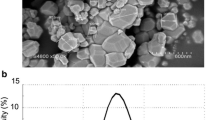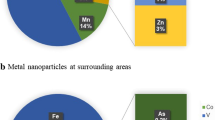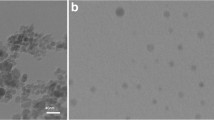Abstract
Hard-metals are made of tungsten carbide (WC) and metallic cobalt (Co) particles and are important industrial materials produced for their extreme hardness and high wear resistance properties. While occupational exposure to metallic Co alone is apparently not associated with an increased risk of cancer, the WC–Co particle mixture was shown to increase the risk of lung cancer in exposed workers. We have previously shown that WC–Co specifically induces a burst of reactive oxygen species (ROS) and in vitro mutagenic/apoptogenic effects in human peripheral blood mononucleated cells (PBMC) used as a validated experimental model. In the present study, PBMCs were treated during a short period (15 min) to focus on the very rapid ROS burst induced by WC–Co. We investigated by microarray the response to WC–Co versus Co2+ ions (CoCl2) after 15 min exposure and found that the oxidative stress response HMOX1 gene was highly expressed in WC–Co-treated samples. This result was confirmed by qRT-PCR, and western blotting was carried out to analyze translational and post-translational regulation of genes belonging to the HMOX1 pathway. We show here that WC–Co, and metallic Co particles although with slower kinetics, but not CoCl2 or WC alone, induced a temporally ordered cascade of events. This cascade implies p38/MAP kinase activation, HIF-1α stabilization, HMOX1 transcriptional activation, and ATM-independent p53 stabilization. These events, and in particular HIF-1α stabilization, could contribute to the carcinogenic activity of WC–Co dusts.






Similar content being viewed by others
References
Anard D, Kirsch Volders M, Elhajouji A, Belpaeme K, Lison D (1997) In vitro genotoxic effects of hard metal particles assessed by alkaline single cell gel and elution assays. Carcinogenesis 18:177–184
Brune B, Zhou J, von Knethen A (2003) Nitric oxide, oxidative stress, and apoptosis. Kidney Int Suppl 84:S22–S24
Bulavin DV, Saito S, Hollander MC, Sakaguchi K, Anderson CW, Appella E, Fornace AJ Jr (1999) Phosphorylation of human p53 by p38 kinase coordinates N-terminal phosphorylation and apoptosis in response to UV radiation. EMBO J 18:6845–6854
Chandel NS, Vander Heiden MG, Thompson CB, Schumacker PT (2000) Redox regulation of p53 during hypoxia. Oncogene 19:3840–3848
Chiacchiera F, Matrone A, Ferrari E, Ingravallo G, Lo Sasso G, Murzilli S, Petruzzelli M, Salvatore L, Moschetta A, Simone C (2009) p38alpha blockade inhibits colorectal cancer growth in vivo by inducing a switch from HIF1alpha- to FoxO-dependent transcription. Cell Death Differ 16:1203–1214
De Boeck M, Lison D, Kirsch Volders M (1998) Evaluation of the in vitro direct and indirect genotoxic effects of cobalt compounds using the alkaline comet assay. Influence of interdonor and interexperimental variability. Carcinogenesis 19:2021–2029
De Boeck M, Kirsch-Volders M, Lison D (2003) Cobalt and antimony: genotoxicity and carcinogenicity. Mutat Res 533:135–152
Dolado I, Swat A, Ajenjo N, De Vita G, Cuadrado A, Nebreda AR (2007) p38alpha MAP kinase as a sensor of reactive oxygen species in tumorigenesis. Cancer Cell 11:191–205
Dumaz N, Meek DW (1999) Serine15 phosphorylation stimulates p53 transactivation but does not directly influence interaction with HDM2. EMBO J 18:7002–7010
Emerling BM, Platanias LC, Black E, Nebreda AR, Davis RJ, Chandel NS (2005) Mitochondrial reactive oxygen species activation of p38 mitogen-activated protein kinase is required for hypoxia signaling. Mol Cell Biol 25:4853–4862
Feng L, Hollstein M, Xu Y (2006) Ser46 phosphorylation regulates p53-dependent apoptosis and replicative senescence. Cell Cycle 5:2812–2819
Gatenby RA, Gillies RJ (2004) Why do cancers have high aerobic glycolysis? Nat Rev Cancer 4:891–899
IARC (2006) IARC monographs on the evaluation of carcinogenic risks to humans, vol 86, Cobalt in hard-metals and cobalt sulfate, gallium arsenide, indium phosphide and vanadium pentoxide, Lyon
Kim HJ, Yang SJ, Kim YS, Kim TU (2003) Cobalt chloride-induced apoptosis and extracellular signal-regulated protein kinase activation in human cervical cancer HeLa cells. J Biochem Mol Biol 36:468–474
Kuwano K (2008) Involvement of epithelial cell apoptosis in interstitial lung diseases. Intern Med (Tokyo, Japan) 47:345–353
Lee JH, Kim HS, Lee SJ, Kim KT (2007) Stabilization and activation of p53 induced by Cdk5 contributes to neuronal cell death. J Cell Sci 120:2259–2271
Lee SY, Jo HJ, Kim KM, Song JD, Chung HT, Park YC (2008) Concurrent expression of heme oxygenase-1 and p53 in human retinal pigment epithelial cell line. Biochem Biophys Res Commun 365:870–874
Leonard SS, Harris GK, Shi X (2004) Metal-induced oxidative stress and signal transduction. Free Radical Biol Med 37:1921–1942
Li X, Shu R, Filippatos G, Uhal BD (2004) Apoptosis in lung injury and remodeling. J Appl Physiol 97:1535–1542
Li X, Dumont P, Della Pietra A, Shetler C, Murphy ME (2005) The codon 47 polymorphism in p53 is functionally significant. J Biol Chem 280:24245–24251
Li Z, Ya K, Xiao-Mei W, Lei Y, Yang L, Ming QZ (2008) Ginkgolides protect PC12 cells against hypoxia-induced injury by p42/p44 MAPK pathway-dependent upregulation of HIF-1alpha expression and HIF-1DNA-binding activity. J Cell Biochem 103:564–575
Lison D (1996) Human toxicity of cobalt-containing dust and experimental studies on the mechanism of interstitial lung disease (hard metal disease). Crit Rev Toxicol 26:585–616
Lison D, Carbonnelle P, Mollo L, Lauwerys R, Fubini B (1995) Physicochemical mechanism of the interaction between cobalt metal and carbide particles to generate toxic activated oxygen species. Chem Res Toxicol 8:600–606
Lison D, De Boeck M, Verougstraete V, Kirsch-Volders M (2001) Update on the genotoxicity and carcinogenicity of cobalt compounds. Occup Environ Med 58:619–625
Lombaert N, De Boeck M, Decordier I, Cundari E, Lison D, Kirsch-Volders M (2004) Evaluation of the apoptogenic potential of hard metal dust (WC- Co), tungsten carbide and metallic cobalt. Toxicol Lett 154:23–34
Lombaert N, Lison D, Van Hummelen P, Kirsch-Volders M (2008) In vitro expression of hard metal dust (WC–Co)-responsive genes in human peripheral blood mononucleated cells. Toxicol Appl Pharmacol 227:299–312
Maxwell P, Salnikow K (2004) HIF-1: an oxygen and metal responsive transcription factor. Cancer Biol Ther 3:29–35
Moreno-Sanchez R, Rodriguez-Enriquez S, Marin-Hernandez A, Saavedra E (2007) Energy metabolism in tumor cells. FEBS J 274:1393–1418
Moulin JJ, Wild P, Mur JM, Fournier-Betz M, Mercier-Gallay M (1993) A mortality study of cobalt production workers: an extension of the follow-up. Am J Ind Med 23:281–288
Moulin JJ, Wild P, Romazini S, Lasfargues G, Peltier A, Bozec C, Deguerry P, Pellet F, Perdrix A (1998) Lung cancer risk in hard-metal workers. Am J Epidemiol 148:241–248
Otterbein LE, Choi AM (2000) Heme oxygenase: colors of defense against cellular stress. Am J Physiol 279:L1029–L1037
Otterbein LE, Soares MP, Yamashita K, Bach FH (2003) Heme oxygenase-1: unleashing the protective properties of heme. Trends Immunol 24:449–455
Rinaldo C, Prodosmo A, Mancini F, Iacovelli S, Sacchi A, Moretti F, Soddu S (2007) MDM2-regulated degradation of HIPK2 prevents p53Ser46 phosphorylation and DNA damage-induced apoptosis. Mol Cell 25:739–750
Sakaguchi K, Herrera JE, Saito S, Miki T, Bustin M, Vassilev A, Anderson CW, Appella E (1998) DNA damage activates p53 through a phosphorylation–acetylation cascade. Genes Dev 12:2831–2841
Salnikow K, Donald SP, Bruick RK, Zhitkovich A, Phang JM, Kasprzak KS (2004) Depletion of intracellular ascorbate by the carcinogenic metals nickel and cobalt results in the induction of hypoxic stress. J Biol Chem 279:40337–40344
Semenza GL (2000) HIF-1 and human disease: one highly involved factor. Genes Dev 14:1983–1991
Semenza GL (2003) Targeting HIF-1 for cancer therapy. Nat Rev Cancer 3:721–732
Semenza GL (2006) Development of novel therapeutic strategies that target HIF-1. Expert Opin Ther Targets 10:267–280
Shieh SY, Ikeda M, Taya Y, Prives C (1997) DNA damage-induced phosphorylation of p53 alleviates inhibition by MDM2. Cell 91:325–334
Shiloh Y (2003) ATM and related protein kinases: safeguarding genome integrity. Nat Rev 3:155–168
Triantafyllou A, Liakos P, Tsakalof A, Georgatsou E, Simos G, Bonanou S (2006) Cobalt induces hypoxia-inducible factor-1alpha (HIF-1alpha) in HeLa cells by an iron-independent, but ROS-, PI-3K- and MAPK-dependent mechanism. Free Radical Res 40:847–856
Uhal BD (2003) Epithelial apoptosis in the initiation of lung fibrosis. Eur Respir J 44:7s–9s
Valko M, Rhodes CJ, Moncol J, Izakovic M, Mazur M (2006) Free radicals, metals and antioxidants in oxidative stress-induced cancer. Chem Biol Inter 160:1–40
Van Goethem F, Lison D, Kirsch-Volders M (1997) Comparative evaluation of the in vitro micronucleus test and the alkaline single cell gel electrophoresis assay for the detection of DNA damaging agents: genotoxic effects of cobalt powder, tungsten carbide and cobalt–tungsten carbide. Mut Res 392:31–43
Warburg O (1956) On the origin of cancer cells. Science 123:309–314
Ziello JE, Jovin IS, Huang Y (2007) Hypoxia-Inducible Factor (HIF)-1 regulatory pathway and its potential for therapeutic intervention in malignancy and ischemia. Yale J Biol Med 80:51–60
Conflict of interest
None declared.
Author information
Authors and Affiliations
Corresponding author
Additional information
Noömi Lombaert and Eleonora Castrucci contributed equally to this work.
Electronic supplementary material
Below is the link to the electronic supplementary material.
Rights and permissions
About this article
Cite this article
Lombaert, N., Castrucci, E., Decordier, I. et al. Hard-metal (WC–Co) particles trigger a signaling cascade involving p38 MAPK, HIF-1α, HMOX1, and p53 activation in human PBMC. Arch Toxicol 87, 259–268 (2013). https://doi.org/10.1007/s00204-012-0943-y
Received:
Accepted:
Published:
Issue Date:
DOI: https://doi.org/10.1007/s00204-012-0943-y




